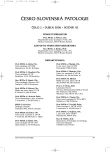Argyrophilic Grain Disease: Case Report of the First Two Cases in the Czech Republic and Review of the Literature
Authors:
R. Matěj; F. Koukolík
Authors‘ workplace:
Department of Pathology and Working Group for Diagnosis and Study
of Neurodegenerative Disorders, Thomayer Teaching Hospital, Prague, Czech Republic
Published in:
Čes.-slov. Patol., 42, 2006, No. 2, p. 66-70
Category:
Overview
Argyrophilic grain disease (AgD) is a relatively newly described neurodegenerative disease with late-onset dementia. Morphologically it is characterized by the presence of abundant spindleshaped argyrophilic grains (ArG) in neuronal processes and coiled bodies in oligodendrocytes. ArG consist of abnormally hyperphosphorylated form of tau protein. AgD is a substrate of at least 5% of all dementia cases with increasing incidence in the old age. Here we report the cases of a 91-yearold woman and an 83-year-old man clinically diagnosed with dementia. Neuropathological, histochemical and immunohistochemical examination of the brain tissue show the changes to be compatible with a definite diagnosis of AgD. This is the first description of two cases of AgD in the Czech Republic.
Key words:
argyrophilic grain disease – dementia – tau protein
Labels
Anatomical pathology Forensic medical examiner ToxicologyArticle was published in
Czecho-Slovak Pathology

2006 Issue 2
Most read in this issue
- Argyrophilic Grain Disease: Case Report of the First Two Cases in the Czech Republic and Review of the Literature
- Tumoriform Endometriosis of the Urinary Bladder in Advanced Pregnancy
- Dedifferentiated Mixed Stromal-Smooth Muscle Tumor of the Uterus. Report of a Case
- Epithelioid Hemangioma of the Foot
